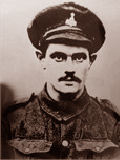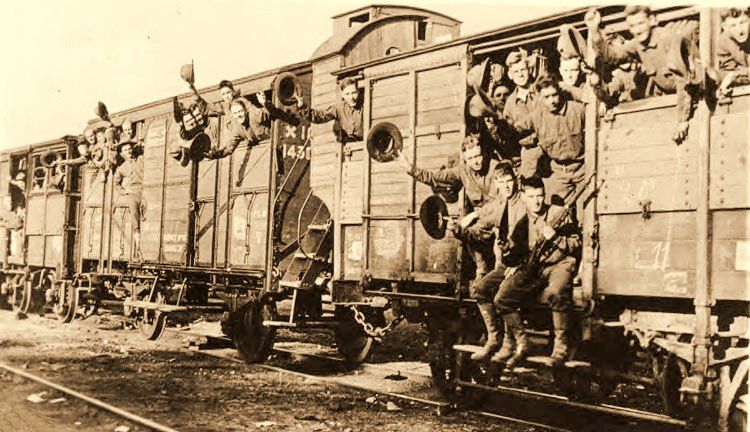13TH FEBRUARY 1917.
4TH YORKS LADS KILLED IN FRENCH RAILWAY ACCIDENT.
The following information has been researched and kindly contributed by the Great Ayton, N Yorks History Group.
|

Cpl David W King.
|
3882 Cpl King David, W. Home at - Bedale N Yorks. Enlisted at Northallerton, N Yorks. Buried at St Sever [Hospital] Cemetery Extension, Rouen.
2055/200411
L/Cpl Etherington Richard. Home at Great Ayton, N Yorks. Enlisted at Stokesley, N Yorks. Buried at Bois Guillaume Communal Cemetery.
These two men were returning to the Battalion after leave or recuperation in England.
They were with 1,100 servicemen from numerous regiments aboard a train which left Le Havre at 6:30am on Tuesday, the 13th February 1917, in the charge of Major G Thornton.
By early evening they were about fifty miles east of Rouen, having averaged barely 30 mph.
Some thirty of them were about to die, not by enemy action, but through a terrible railway accident.
The events were clearly described in the "Journal de Rouen" two days later, translated here.
|

British Soldiers loaded into wooden carriages, similar to the ones involved in this accident.
|
On Tuesday evening, 13 February 1917, a railway disaster occurred on the between Rouen and Amiens, a short distance before the station at Serqueux, and about 75 kilometres to the east of Rouen.
This is in the municipality of Roncherolles-en-Bray.
The tragic accident caused the death of … passengers and injuries to a further … passengers (the number of casualties was censored by the authorities at the time).
It was about eight o'clock in the evening.
A goods train was waiting near the signal by the level crossing at l'Epinay until the way ahead was clear.
When the signal was cleared, the train began to move, but a coupling broke and a string of trucks began to move backwards down the gradient in the track.
The goods train was being followed by a passenger train.
The driver of the passenger train, seeing the runaway wagons coming towards him, realised the danger and that it was difficult to avoid an accident.
|
He shut off the steam and applied the brakes, but the runaway wagons collided with his locomotive.
This locomotive and the leading passenger carriages remained on the tracks, but a coupling broke around the middle of the train where the lighter carriages were, and six of them derailed and piled up on top of one another.
The train was crowded. Soon cries of distress calls for help were heard coming from the derailed carriages.
The alarm was immediately raised at the station at Serqueux.
The rescue organization was difficult. However, a detachment from a British engineer company and some Indo-Chinese workers arrived quickly, and began to working to clear a way through the wreckage.
It was dark and it was almost impossible to see.
Some trees were felled and bonfires started, and work was carried out under the light from the fires.
There was a great danger that the carriages piled up on one another might topple over, adding to the distress of those trapped in the wreckage and desperately calling for help.
More trees were felled and used as props to support the derailed carriages.
As the passengers were reached, it became apparent that there were a number of dead bodies, which were carried to the station at Serqueux.
English and French medical staff from the town of Forges-les-Eaux, just two kilometres south of Serqueux, arrived and took care of the many wounded, including those with serious injuries who were given emergency dressings
at the scene of the accident.
he less serious cases were taken to the hospital at Forges-les-Eaux.
When everyone had been treated, they were put on another train which had been following the derailed passenger train, but could obviously not proceed beyond the crash site.
This train then went back to Rouen, where the injured were sent to hospitals in the city.
Unfortunately some of the seriously injured died on the journey back to Rouen.
The funerals of the victims of this disaster will take place at Bois-Guillaume, a northern suburb of Rouen.
As soon as he was informed of the accident on Tuesday evening, M. Bruillard, an inspector with the Compagnie de Chemin de Fer du Nord, went to Serqueux.
He stayed there all night, supervising the work to clear the tracks after the dead and wounded had been removed from the wreckage.
The engineer and station master at Serqueux, and the police from Forges-les-Eaux were also quickly on the scene.
In the morning M. Villèle, Chief Inspector of the railway company, went to Serqueux.
Clearing the tracks proved very complicated. The wooden carriages were completely smashed up, and the railway line twisted.
However the work was done with much speed and skill, under the direction of M. Bruillard, and was completed the following midday, with the normal train service resuming at two o'clock in the afternoon.
Prior to this, trains leaving Rouen for Amiens had been diverted via Buchy and Clères.
Tuesday's disaster cast the deepest gloom over Serqueux and the surrounding countryside.
After the crash many members of the public visited the accident site. In Rouen, word quickly spread of this terrible event and residents mourned the fate of the unfortunate victims' tragic death.
The lighter carriages referred to in the report were five obsolete wooden carriages, pressed into service due to the shortage of rolling stock.
The exact number of fatalities is open to doubt. Certainly there are 26 men buried in the Communal Cemetery at Bois-Guillaume, including Richard Etherington.
Their actual deaths would have been on 13 February but the date recorded is the following day.
Some of the 54 men who were badly injured subsequently died, and the total number of fatalities was later thought to be 33.
|
|



